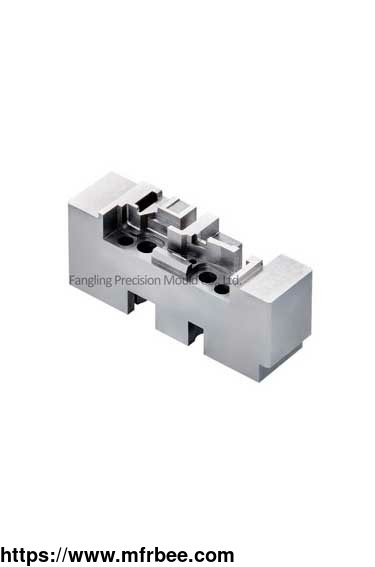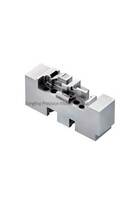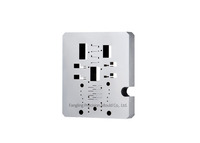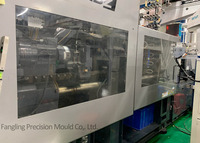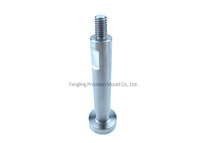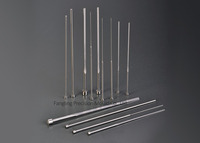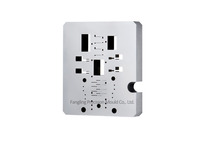PRECISION MOLD PARTS/SPARE PARTS
Specifications
This shape of a mold is predetermined by a mould, a block that has been hollowed out. Aluminum, steel, alloys, and copper are the most common materials used to build it. It's made up of various
other mold parts, too. Our mold spare parts include lifters and ejectors as well as guides and bushings in the form of alignment devices and pins on the base.
Types of Precision Mold Parts/Spare Parts
Injection to maintain the productivity of our customers, we keep Mold Replacement Parts on hand. Customized mold spare parts may be produced on time using client programme files and data in
addition to standard components. The British name for mould is the same as the American one.
MOLD SPARE PARTS BENEFITS
The mould can accept a broad range of materials of various types. Almost all metal parts, such as magnets, tubes, mounting brackets, and screws, fall under this group. This gain reflects the shift
to plastic components from metal components that have occurred in many industries over the last several decades. Weight savings may be achieved by using plastic, and its operational durability can
be comparable to metal, depending on the application. Corrosion does not affect it in the same way as it does most other metals. There are several advantages to having this kind of access. To get
you started, here are seven things to consider.
Plastic components lighter than metal counterpart
Plastic components, on average, are lighter than their metal counterparts by up to 50%. The economy with which fuel is utilised and the ease with which surgical equipment is used may benefit from
weight reduction.
Longevity
A major advantage of insert moulding is that it allows for better product design and manufacturing. It is impossible to achieve the degree of precision when inserting inserts into a mould design
using any other process. To summarise, plastic parts with built-in components are significantly more reliable and durable.
Size is the third factor.
By using the insert moulding technology, it is possible to produce considerably more compact or thinner components while maintaining their strength and functionality. Using automobile parts as an
example is simple enough. There will be more room in the car since the door, and console elements have been reduced in thickness.
Cost-Effective
It is possible to save money through insert moulding in various ways. To begin with, they allow for the use of raw materials that are much less costly. Resins are often less expensive than metals
because of this.
Efficient operation, number 5.
Insert moulding may speed up the manufacturing process by eliminating the need for a second assembly step. A separate activity is no longer necessary since the process of introducing metal or other
components are integrated into the moulding phase. These methods need specialised personnel and equipment, which results in significant time and cost savings.
A Variety of Materials Available
Plastic resins of all kinds may be employed during the insert moulding process. Thermal plastics, which may be recycled, are included in this list. It's most common to see these three
thermoplastics in one form or another. All of these materials are strong and lightweight, making them ideal for a wide range of applications, from everyday household products to heavy-duty
industrial ones.
Injection Molding Applications
Injection moulding is a manufacturing method that is used to make plastic components. Using great pressure, molten plastic is pushed into a mould with the opposite shape to get the desired shape.
Using metal, usually steel or aluminium, a mould maker constructs the mould and then precisely machines the material to obtain the desired component qualities. You can easily have an injection
moulding machine spare parts list online.
INJECTION MOLDING APPLICATIONS
It is normal practice to use injection moulding to create a wide variety of injection molding machine spare parts, from the smallest parts to the whole body panels of vehicles.
UNDERSTANDING MOLDS AND TOOLING IN PLASTICS MANUFACTURING
For many people, the first thing that springs to mind when discussing moulds and tooling and moulding machine spare parts is the components that are produced using processes such as blow moulds or
injection moulds.
Molds
The term "mould" refers to a block that has been hollowed out in order to produce a certain shape for the completed product. A wide range of materials, including aluminium, steel, alloys, and
copper, may be employed in its construction. In addition, it consists of several components.
In this area, you'll find everything from pins and bases to lifters and ejectors to guides and bushings.
Choosing the right mould is critical since it has such a significant impact on the final product's look. Having a thorough understanding of what the final product will look like is essential for
the creator. As a result, the whole chain would have to be sacrificed, from the tiniest components to the most important roles they serve.
01
Injection moulding
To better understand injection moulding and mould spare parts, you have a better understanding of the role that moulds play in the production process.
Any material may be pumped into a mould during the injection moulding process, which should come as no surprise. Metals, polymers, glass, and elastomers are just a few of the materials that may be
employed in the manufacturing process.
Initially, the material is heated in a barrel before being poured into the mold's centre and cooled. Afterwards, the material becomes more firm when it cools, resulting in the finished product.
02
Blown-Air Molding
Blow moulding machine spare parts may be used to make hollow plastic components. Injection blow moulding, injection stretch blow moulding, and extrusion blow moulding are all viable options for
completing this job. The plastic substance is blasted into the mould using air in each process. Afterwards, the plastic cools down, resulting in the final product.
03
Tooling
Finding and acquiring the numerous injection molding spare parts and pieces of equipment required to construct something is what tooling involves. To name just a few, the most popular subfields are
cutting patterns, equipment and jigs/fixtures, as well as gauges, dies, moulds, and dies themselves.
Make sure to keep in mind the impact the tooling process has on both product quality and the overall cost of the project. Because of this, if you are in charge of the process, you must proceed with
extreme care.
04
MOLD SPARE PARTS FAQS
01
What are the parts of molds?
A mold is a hollowed out block that sets the shape of the product being made. It can be made of different materials, the most common of which are aluminum, steel, alloys and copper. It also has
different components. These components include pins, bases, lifters, ejectors, guides, bushings, and alignment devices
What are the 3 main parts of the injection mold?
Injection moulding uses a special-purpose machine that has three parts: the injection unit, the mould and the clamp.
What are the parts used for mold alignment?
Guide pins and bushings. These provide the primary alignment of the mold halves. Parting line interlocks. These provide the precise centerline alignment between the A, B, and stripper plates.
As a mold parts supplier, we provide precision mold services, injection moulding spare parts, injection molding spare parts, precision moulded components, precision mould parts, precision mold
components, stamping components, etc. For more information, please feel free to contact us!
- Country: Afghanistan
- Address: "No.10 Hongshi Rd., No.1 Industrial Zone, Lu Dong Management Zone,Humen Town, DongGuan City, Guangdong province, 523935, China"
- Contact: Fangling mold
